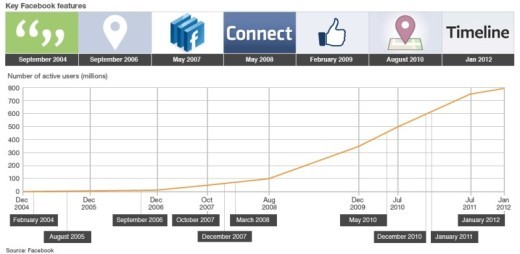A brief history of social media (something you may not have known yet) and 4 assumptions about their future (Part 2)

When people ask me what my favorite book is, I invariably reply: “The Pirates Dilemma”. The book talks about disco, hip-hop, punk, graffiti and how modern technologies have served as the basis for ideas and innovations in the culture of young people, which made it more local and at the same time more global. It really captures.
And looking back you can find the roots of the modern social media revolution - back in the distant 70s or even earlier.
The first part is here .
')
Why Facebook has become the leading social network in the world.
“From Myspace, the world learned that social networks are interesting, but the perfect product was created by Facebook.” - Mike Jones (Mike Jones), the former CEO of Myspace.
Facebook has climbed to the top of the social media world with a figure of about 1.49 billion monthly active users.
You can write a whole book about how Facebook has become the most powerful social network of modern times, but I will try to briefly tell you in a few sentences about the striking rise of Facebook.
Realistic approach
Facebook was the first social network to encourage users to use their real names, not nicknames or pseudonyms. Mike Jones talks about this:
“MySpace itself set boundaries that prevented users from fully enjoying the network — participants were forced to use anonymous nicknames instead of their real names. Facebook went a completely different way, encouraging the use of real user names, and when the audience managed to convey this thought, and people saw that there was no great risk, this tradition took root, and Facebook continued its development, not returning to this issue. This important difference between the two social networks turned out to be a factor that largely influenced how different the fates of the two companies were. ”
Desire to change
In the days of Facebook, the company followed the motto “move fast and make mistakes”. One of the compelling reasons that Facebook became a leader was precisely the transformation of this motto into action.
Facebook never stood still, the company was never afraid to make unsuccessful changes to the platform. This graph shows some of the major network updates in the period 2004-2012:

Here are some important dates:
- September 2004: A wall appeared on which users could post and share content in their accounts.
- September 2006: A news feed appeared - users can now follow what their friends are doing on Facebook.
- January 2012: The opportunity to display the profile in the form of a chronicle became available to all users.
The appearance of the news feed
Facebook news feed was a key part of web success. In the early social networks (and on Facebook before the introduction of the news feed), you had to search for content published by the people with whom you are connected.
In the news feed you can find the content of friends, various updates and discussions at every step, which just gives Facebook a really social sound.
Understanding the Importance of Strong Links
We previously discussed the importance of social networking links and this is what was an important reference for Facebook. Alex Schultz explained this in his business development lecture in his Y Combinator:
“Zuckerberg told Y Combinator that within two weeks, people find 10 friends; that is why we have focused on this metric. The most important thing on social media sites is connecting with friends, because without this you’ll have a completely empty news feed and you’re not going back; you will never receive any alerts, you will not have friends on the site who will be able to tell you about what is happening in their profiles. ”
And what is it all about?
"The game continues. Facebook is currently the platform on which various types of applications are built. But this is not the end. It would be incredibly presumptuous and selfish of me to believe that Facebook is the finale of the story. The only thing that can put an end to this story is the emergence of a social network as a kind of artificial super-intelligence that will take over the world. ” - Sean Parker.
At the time of the prosperity of Myspace, no one outside of one of the rooms at Harvard University dorm could have imagined Facebook was born, nor could Facebook foresee the appearance of Snapchat and changes in how people communicate with each other online.
Facebook has reached the highest peak, and like a boxer who has become a world champion, he is entering new hard battles to defend his title.
Four predictions about the future of social media
And although the future of social media is unclear, I suggest looking at my predictions about what we will see in the coming years.
MORE ATTENTION TO PERSONALITY
One of the reasons Facebook went around Myspace was because it was the first social network that allowed the user to remain himself (using his real name). Together with the development of this principle, social media will be more and more personalized. services.
Co-founder of Beme and director Casey Neistat explains it this way:
“Social media should create a digital or virtual version of who we are as people. Instead, we see a modified, calculated and corrected version of ourselves. ”
Social networks will become more close to reality. Greater attention will be paid to exactly who we really are, what kind of personalities we are, as opposed to what can be observed today - refined versions of ourselves that we promote.
Platforms will go beyond static images and profiles based on written text. They evolve in order to appear more real, more close to the user. We already could observe this tendency with the advent of video in a profile on Facebook.
CAREFULLY SELECTED CONTENT
The “lifetime” of a tweet is 18 minutes. The average Facebook user has daily access to 1500 posts, but views about 300.
Content amazes with its abundance. And this is a problem both for users of the platforms and for the platforms themselves.
Currently, the content is massive and is addressed to our subscribers under the label of relevance. But this is not ideal. How content is delivered to users will become more personalized, just as social networks will pay more attention to the individuals who register with them.
In the coming years, the content will become as if it was selected specifically for us and handed over personally. We will be able to select content for specific people in real time based on their daily interests. Facebook is already testing AI in order to determine exactly what is captured in photos, in order to provide users with the most relevant content.
It creates powerful values for social network users (providing them with relevant information every time they log in) and help them feel connected to other people, brands and their favorite pages. This will serve the popularity and long life of social networks.
Such an approach to content will also have a beneficial effect on users' fascination with the proposed content - they will have an incentive to read and view it. And this is completely opposite to the mass approach that is widespread today.
STATIC IMAGES WILL GO INTO THE PAST
Video and multimedia content is already popular in social media. The most commonly viewed Facebook post types are videos, and Twitter’s own videos are awesome:
Most Twitter users (82%) watch video content on Twitter, and the lion’s share is on small screens. 90% of views are carried out on mobile devices, in accordance with our own data. But Twitter users are not just watching the video, leaning back in their chairs - they also create the video themselves. In the US, Twitter users are 1.9 times more likely to publish videos online (anywhere) than regular Internet users.
Along with the video, the GIF files also successfully returned to social media.
“When Myspace disappeared, and Facebook came up with policies against moving GIF images, the Internet was cleared of twinkling images in the spirit of the 90s, which were very common,” explains Kevin Burg, one of the creators of Cinemagraph.
“And GIFs became popular again with the arrival of Tumblr, which had a creative community, as well as the high bandwidth and the ability to upload files up to 512 KB, as well as an easy way to share gifs. Tumblr preached the idea of creating rich content, and many people experimented with how to use the 512KB most effectively and creatively. ”
The rise in popularity of Tumblr, along with sites like Giphy, paved the way for the return of GIF files to the mainstream. Facebook and Twitter now also welcome GIF files (in Buffer, we also started to support this trend).
Now we are experiencing a revolution, as a result of which each company will become a media company, but in the future each company will have to become a multimedia company.
DURATION OF ATTENTION CONCENTRATION BECOMES MORE SHORT
Attention is becoming an increasingly scarce resource. Microsoft's research has shown that the average user’s attention on the Internet has dropped significantly from 12 seconds in 2000 to only 8 seconds in 2015.
In order to counteract the decrease in user attention span, the content will become more interactive and allow us to create our own unique experience. One of the ways this is already being introduced is panoramic video on platforms such as YouTube.
We would be interested to hear your opinions and predictions about the present and future of social media. What social network was the first resource of this kind for you? How has social media changed since then? What do you think their future is?
Source: https://habr.com/ru/post/297160/
All Articles